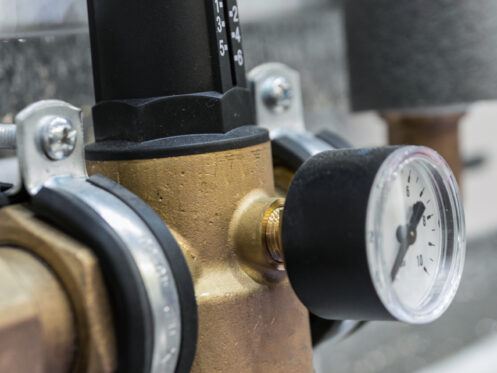There are many reasons for having to adjust your home’s water pressure. Whether it’s low pressure in the shower or no water at all in the kitchen, knowing how to adjust the pressure is crucial to your home’s comfort and convenience. To further understand how water pressure works in your home, it’s helpful to know why homeowners adjust the pressure.
Preventing Damage to Fixtures and Appliances
High water pressure puts an excessive amount of stress and unnecessary strain on pipes, fixtures and appliances. Over time, the extreme wear and tear can lead to leaks, bursts or even premature failure of these parts. Knowing how to adjust the water pressure allows homeowners to reduce the pressure, thus extending each component’s lifespan instead of hurting it.
Reducing Water Waste
High water pressure also results in a lot of water waste. Think about it. High water pressure means there is more pressure forcing the water through the hose or fixture. This ultimately means there is more water coming out in a shorter amount of time. By reducing water pressure, you can greatly minimize water waste and lower your water bills.
Avoiding Water Hammer
If your home regularly experiences sudden surges of water pressure, you might hear banging noises coming from the pipes. This is water hammering, and it occurs frequently in condos, old homes, duplexes, apartment buildings and multi-family residential structures. The easiest way to get rid of the noise is by turning down the water pressure.
Enhancing Comfort and Convenience
Low water pressure is just as aggravating as high water pressure. It can significantly reduce the pleasure of commonplace activities such as taking a shower, doing the dishes and even watering plants inside and outside of your home. Knowing how to increase the pressure can make your home much more comfortable.
Complying with Local Codes and Regulations
The best way to stay in compliance with local rules and regulations in Littleton is to have a plumber install a water pressure regulator. This is especially applicable to homes with water pressure that exceeds 80 psi. Not only can this keep you in compliance, but it can prevent you from wasting thousands of gallons of water each year. As a result, you’ll notice lower water bills.
Balancing Pressure Throughout the System
Different areas of a big house or a building with several units will often have varying water pressure. If you know how to change the pressure, you can make sure the entire residence has the same amount of pressure. This improved distribution of water not only enhances comfort but puts less strain on the plumbing system as well.
How to Adjust the Water Pressure
No matter the reason for adjusting your home’s water pressure, there are several safety tips you need to follow. For starters, it’s important to shut off the main water supply before making any adjustments. This prevents any unexpected surges of water from causing damage or injury.
It’s equally important to use the appropriate tools when making adjustments. This will likely require a pressure gauge and wrench. When you have the right equipment, you can get the job done faster and with less chance of harm. Safety gear to wear when adjusting water pressure includes safety glasses and gloves.
Always start by making small adjustments. After each gradual adjustment, check the water flow to see if it meets your preferences. If you make large adjustments, it puts your fixtures and pipes at risk for damage due to sudden surges in pressure.
Follow the simple steps outlined below to adjust the water pressure. If you don’t feel comfortable adjusting the pressure, you can always have a plumber adjust it for you.
- Turn off the main water supply
- Locate the pressure regulator
- Attach the pressure gauge
- Turn on a faucet to release residual pressure
- Read the initial pressure
- Adjust the pressure regulator
- Check the pressure
- Make gradual adjustments, if necessary
- Secure any connections you loosened to get to the valve
- Turn on the main water supply
- Monitor for leaks
Common Water Pressure Repairs and What to Do About Them
Adjusting water pressure is usually fairly simple, but it won’t fix all plumbing problems. Read on to learn about four common water pressure repairs and what to do about them. Some of the more common problems definitely require help from a professional plumber.
Low Water Pressure
Clogged shut-off valves, aerators and showerheads can all cause low water pressure. Leaks in the plumbing system and municipal supply issues are other possible causes. To fix low water pressure, you need to make sure all shut-off valves are completely open. You may also need to replace your home’s showerheads. If a water leak is causing the low pressure, a plumber can fix the leak.
High Water Pressure
A faulty pressure-reducing valve (PRV) is a common culprit for high water pressure. It can also occur due to the municipal supply pressure being too high. Either way, repairing a faulty PRV or installing a new one will likely fix the problem.
Water Hammer
If lowering the water pressure doesn’t fix water hammering, a professional plumber can choose from one of three ways to fix the problem. However, all of these require exposing plumbing pipes. The first way involves the plumber inspecting the pipes to make sure they are all well connected. It sometimes requires adding clips or plumber’s tape. Ensuring a secure connection keeps the pipes from moving if they come under a lot of pressure again.
The second method for addressing water pounding involves locating where the pipes emerge from the wall near the sink and the toilet. If the plumber sees any 90-degree elbows, he can put tees in their positions and cap them off with a 12-inch length of pipe. This air-filled space dampens the impact by soaking up the pressure surge causing the hammering. This is a temporary fix and will likely fail at some point in the near future, causing the hammering to start again.
The third and best way to fix water hammering is to have a plumber add an in-line surge arrester. This requires cutting into the water line and can become dangerous. This is why it’s important to have a certified technician perform the installation.
Fluctuating Water Pressure
Pressure variations in the municipal water supply, leaks or obstructions in the plumbing system or a malfunctioning pressure regulator can result in fluctuating water pressure. Installing a PRV may fix the problem. If it doesn’t, a plumber can inspect and repair any leaks or obstructions in the plumbing system. If the pressure regulator is the source of the problem, the plumber will need to repair or replace it.
Having a good understanding of the water pressure in your home can increase its overall comfort. Adjusting the pressure can improve appliance and fixture performance, help you avoid water leaks, minimize the amount of water you waste and make it easier to detect possible plumbing issues. Here at Summit Heating, A/C, Plumbing & Electrical we help homeowners with water pressure, heating and cooling and electrical services. If you need help adjusting your home’s water pressure, give Summit Heating, A/C, Plumbing & Electrical a call.


